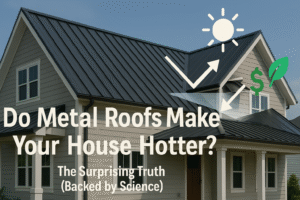Do Metal Roofs Make Your House Hotter? The Surprising Truth (Backed by Science)
No, a properly installed metal roof does not make your house hotter. In fact, it’s the opposite. Due to its high solar reflectivity and ability to quickly release heat, a modern metal roof can make your home significantly cooler and reduce summer energy bills by up to 40% compared to a traditional dark asphalt shingle roof.
It’s one of the most persistent myths in home improvement: “Won’t a metal roof turn my attic into an oven?” It seems logical, right? We all know how hot a piece of metal gets when left in the sun. But this is where common intuition gets the science completely wrong. A metal roof isn’t like a frying pan; it’s a highly engineered system designed to combat the sun’s heat in ways that traditional roofing materials simply can’t match.

About the Author: John Carter
Building Science Consultant & Energy-Efficient Roofing Expert
For over 20 years, I’ve specialized in designing and overseeing the installation of high-performance roofing systems, particularly in the demanding climates of Florida, Texas, and Arizona. My work involves helping architects and homeowners understand the flow of heat and moisture in a building. I’ve conducted dozens of thermal imaging tests and energy audits, and I’ve seen firsthand the dramatic cooling effect of a properly installed metal roof. This guide is based on that field data and established building science principles.
This article will debunk the “hot metal roof” myth once and for all. We’ll dive into the science of “cool roofing,” explain the three key properties that allow metal to outperform other materials, and show you how the entire roofing system works together to keep your home comfortable and your energy bills low.
The Science of Cool: Why Your Intuition About Metal is Wrong
The reason we think metal gets hot is because of its high thermal conductivity. If you touch a metal pole in the sun, it feels hot because it rapidly transfers heat *to* your hand. An asphalt shingle, with its lower conductivity, feels less hot to the touch but is actually storing a massive amount of heat—acting like a thermal battery. This stored heat is what slowly radiates down into your attic all afternoon and evening.
To understand why metal roofs are cooler, we need to look beyond simple touch and focus on the three ways heat moves:
- Conduction: Heat transfer through direct contact.
- Convection: Heat transfer through the movement of air or liquid.
- Radiation: Heat transfer through electromagnetic waves (this is how the sun heats the Earth).
The primary source of heat gain for a roof is **solar radiation**. A “cool roof” is one that is exceptionally good at defeating this radiant heat. This is where metal shines.
The 3 Pillars of a Cool Metal Roof
- High Solar Reflectivity: It reflects a huge portion of the sun’s energy back into the sky.
- High Thermal Emissivity: It quickly releases the small amount of heat it does absorb.
- Low Thermal Mass: It’s too thin to store significant amounts of heat.
1. Solar Reflectivity (or Albedo)
Think of wearing a white t-shirt versus a black one on a sunny day. The white shirt reflects sunlight and keeps you cooler. Modern metal roofs work the same way but are far more advanced. They are coated with special reflective pigments that can reflect anywhere from 60% to 90% of the sun’s solar radiation, even in darker colors. In contrast, a typical dark asphalt shingle might reflect only 5% to 20%.
The Cool Roof Rating Council (CRRC) and ENERGY STAR® certify products that meet high standards for reflectivity. Choosing a certified “cool roof” color is a key factor, especially when considering if metal roofs are good in Florida or other hot climates. Knowing that you can paint a metal roof with these advanced coatings later on also adds to its long-term value.
2. Thermal Emissivity
This is the secret weapon of metal roofing. Emissivity is a measure of a material’s ability to release absorbed heat. Metal has very high thermal emissivity (typically 0.85 to 0.95). This means the small amount of heat it does absorb is radiated away from the roof very quickly. Asphalt shingles, on the other hand, have low emissivity. They hold onto heat like a brick, continuing to warm your attic long after the sun has gone down.
3. Low Thermal Mass
A metal roofing panel is very thin and lightweight. It simply doesn’t have the physical mass to store much heat energy. An asphalt shingle is thick, dense, and heavy. It’s a “high thermal mass” material. On a hot day, an asphalt roof can store a tremendous amount of heat, which it will continue to radiate downwards into your attic for hours after sunset. A metal roof cools down within minutes of the sun disappearing.
Metal vs. Asphalt Shingles: A Cooling Performance Showdown
According to research by the Oak Ridge National Laboratory, homes with “cool” metal roofs can see energy savings for cooling of 20% to 40% compared to typical asphalt shingle roofs. Let’s break down why the difference is so stark.
| Feature / Metric | “Cool” Metal Roof | Dark Asphalt Shingle Roof |
|---|---|---|
| Peak Surface Temperature | 100-120° F | 160-190° F |
| Solar Reflectivity | 60% – 90% | 5% – 20% |
| Heat Emissivity | High (Releases heat quickly) | Low (Holds heat for hours) |
| Heat Transfer to Attic | Significantly Reduced | Very High |
| Annual Cooling Energy Savings | Up to 40% | Baseline (0%) |
It’s Not Just the Metal, It’s the System
The performance of a metal roof isn’t just about the panel itself. The way it’s installed creates a powerful, passive cooling system.
The Critical Air Gap: Above-Sheathing Ventilation
Unlike shingles which are nailed directly to the roof deck, many metal roofing systems are installed on a grid of wood battens or have profiles that create a continuous air gap of 1-3 inches between the metal and the roof deck. This air gap is a game-changer:
- It’s a Thermal Break: The air gap dramatically reduces conductive heat transfer from the panel to the deck.
- It Creates Convection: As the air in the gap heats up, it naturally rises and exits at the ridge, pulling in cooler air from the eaves. This process, called “above-sheathing ventilation,” removes a massive amount of heat before it ever has a chance to enter your attic.
This is a fundamental advantage that shingle roofs do not have. This ventilation is also a reason metal performs so well compared to other durable options like the flat roofs found on many commercial buildings.
Essential Components for a Cool Attic System
A cool metal roof is your first and best line of defense against summer heat, but to create a truly energy-efficient system, you need to pair it with other key components. Proper installation requires great care, and the use of the best roof harnesses is non-negotiable for safety. Below are a few products that I recommend to clients to maximize their cooling performance and energy savings.
RadiantGUARD Radiant Barrier Insulation
A radiant barrier is the perfect partner for a metal roof. This is a highly reflective material (like industrial-grade aluminum foil) that you staple to the underside of your roof rafters inside the attic. It stops up to 97% of the radiant heat that *does* make it through the roof deck from entering your attic space. Combining a cool metal roof with a radiant barrier is the ultimate one-two punch against summer heat gain.
Check Price on AmazonRemington Solar Powered Attic Fan
While passive ventilation (ridge and soffit vents) is essential, you can supercharge your attic’s cooling with a solar-powered fan. This device uses a small solar panel to power a fan that actively pulls hot air out of your attic during the day. It costs nothing to operate and can drastically lower attic temperatures, reducing the load on your AC. This is especially effective in homes with complex rooflines where passive ventilation is challenging.
Check Price on AmazonEtekcity Infrared Thermometer Gun
Don’t just take my word for it—see for yourself. An infrared thermometer is an affordable tool that lets you measure surface temperatures instantly. On a sunny day, point it at your neighbor’s black asphalt roof, then at your light-colored metal roof. The difference will be dramatic and will instantly make you a believer in cool roofing technology. You can also use it to find hot spots in your attic or walls.
Check Price on AmazonFrequently Asked Questions
Does the color of the metal roof really make a big difference?
Yes, but maybe not as much as you’d think. While a white or light-colored roof will always be the absolute coolest, modern “cool-pigment” technology allows even darker colors like charcoal, green, and brown to be highly reflective. An ENERGY STAR certified dark green metal roof can be significantly cooler than a non-certified light grey one. The key is to look for the ENERGY STAR or CRRC label, not just the color.
Are metal roofs noisy in the rain?
This is another common myth. The “tin roof” sound people imagine is from old barns where the metal was installed directly over open rafters. Modern residential metal roofs are installed over a solid roof deck and underlayment, often with an air gap and attic insulation below. This assembly deadens the sound to a level that is typically no louder than an asphalt shingle roof.
Do metal roofs need special maintenance to stay cool?
Generally, no. The factory-applied coatings are extremely durable. A simple rinse with a hose once a year can help remove any dirt or pollen that might slightly reduce reflectivity. For any nicks or scratches, it’s wise to have the proper materials on hand, like the best roof sealant or roofing tape recommended by the manufacturer, to prevent corrosion and maintain the roof’s integrity.
What about pest control with a metal roof?
A properly installed metal roof is one of the most pest-resistant systems available. The tight seams and durable material make it very difficult for animals to chew through. Issues with pests are almost always related to gaps in the installation. This is why it’s also a good idea to deal with potential entry points and consider preventative measures, from ensuring homeowners know that roof rats are dangerous to installing the best bird spikes on ledges after the roof is complete.
Final Verdict: A Cool Investment for a Hot Climate
So, do metal roofs make your house hotter? The science and real-world data are clear: **absolutely not.** It’s a myth born from a misunderstanding of how heat works. A modern, properly installed “cool” metal roof is a superior system for rejecting solar heat, keeping your attic and home cooler, and significantly lowering your energy bills.
By reflecting solar radiation, quickly releasing absorbed heat, and utilizing a ventilated air gap, a metal roof is one of the smartest investments a homeowner in a warm climate can make. It’s a decision that pays you back every summer for decades to come, especially when you consider the potential financial implications of a failing roof and navigating insurance claims, a situation where homeowners often wonder what happens if they don’t use their insurance money.
Don’t let outdated myths steer you away from a superior technology. A cool metal roof is the single most effective way to beat the heat from the top down.




